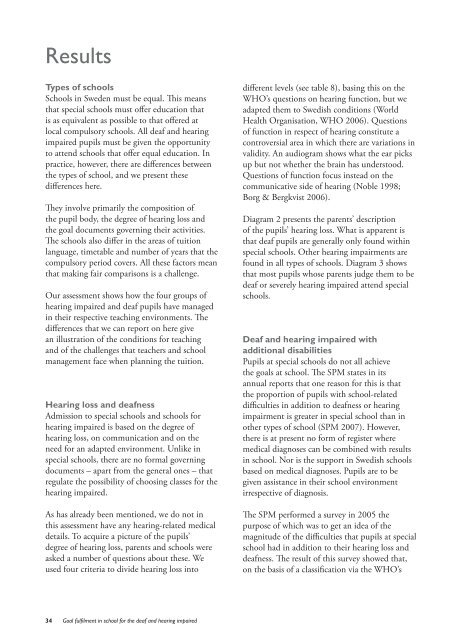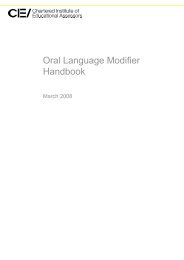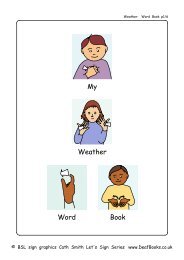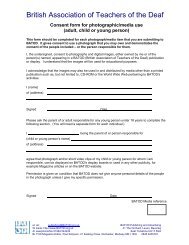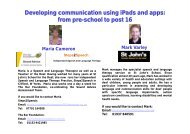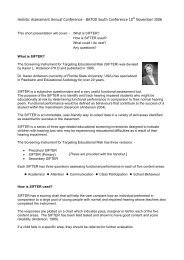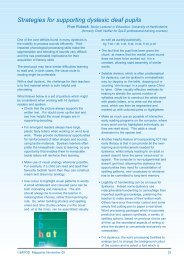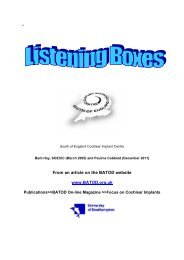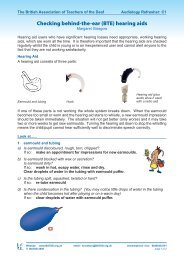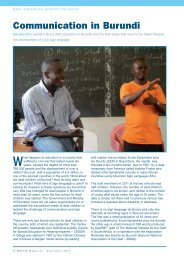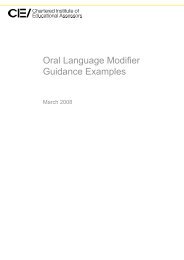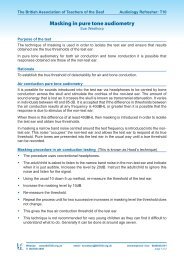Goal fulfilment in school for the deaf and hearing impaired - batod
Goal fulfilment in school for the deaf and hearing impaired - batod
Goal fulfilment in school for the deaf and hearing impaired - batod
- No tags were found...
Create successful ePaper yourself
Turn your PDF publications into a flip-book with our unique Google optimized e-Paper software.
ResultsTypes of <strong>school</strong>sSchools <strong>in</strong> Sweden must be equal. This meansthat special <strong>school</strong>s must offer education thatis as equivalent as possible to that offered atlocal compulsory <strong>school</strong>s. All <strong>deaf</strong> <strong>and</strong> hear<strong>in</strong>g<strong>impaired</strong> pupils must be given <strong>the</strong> opportunityto attend <strong>school</strong>s that offer equal education. Inpractice, however, <strong>the</strong>re are differences between<strong>the</strong> types of <strong>school</strong>, <strong>and</strong> we present <strong>the</strong>sedifferences here.They <strong>in</strong>volve primarily <strong>the</strong> composition of<strong>the</strong> pupil body, <strong>the</strong> degree of hear<strong>in</strong>g loss <strong>and</strong><strong>the</strong> goal documents govern<strong>in</strong>g <strong>the</strong>ir activities.The <strong>school</strong>s also differ <strong>in</strong> <strong>the</strong> areas of tuitionlanguage, timetable <strong>and</strong> number of years that <strong>the</strong>compulsory period covers. All <strong>the</strong>se factors meanthat mak<strong>in</strong>g fair comparisons is a challenge.Our assessment shows how <strong>the</strong> four groups ofhear<strong>in</strong>g <strong>impaired</strong> <strong>and</strong> <strong>deaf</strong> pupils have managed<strong>in</strong> <strong>the</strong>ir respective teach<strong>in</strong>g environments. Thedifferences that we can report on here givean illustration of <strong>the</strong> conditions <strong>for</strong> teach<strong>in</strong>g<strong>and</strong> of <strong>the</strong> challenges that teachers <strong>and</strong> <strong>school</strong>management face when plann<strong>in</strong>g <strong>the</strong> tuition.Hear<strong>in</strong>g loss <strong>and</strong> <strong>deaf</strong>nessAdmission to special <strong>school</strong>s <strong>and</strong> <strong>school</strong>s <strong>for</strong>hear<strong>in</strong>g <strong>impaired</strong> is based on <strong>the</strong> degree ofhear<strong>in</strong>g loss, on communication <strong>and</strong> on <strong>the</strong>need <strong>for</strong> an adapted environment. Unlike <strong>in</strong>special <strong>school</strong>s, <strong>the</strong>re are no <strong>for</strong>mal govern<strong>in</strong>gdocuments – apart from <strong>the</strong> general ones – thatregulate <strong>the</strong> possibility of choos<strong>in</strong>g classes <strong>for</strong> <strong>the</strong>hear<strong>in</strong>g <strong>impaired</strong>.As has already been mentioned, we do not <strong>in</strong>this assessment have any hear<strong>in</strong>g-related medicaldetails. To acquire a picture of <strong>the</strong> pupils’degree of hear<strong>in</strong>g loss, parents <strong>and</strong> <strong>school</strong>s wereasked a number of questions about <strong>the</strong>se. Weused four criteria to divide hear<strong>in</strong>g loss <strong>in</strong>todifferent levels (see table 8), bas<strong>in</strong>g this on <strong>the</strong>WHO’s questions on hear<strong>in</strong>g function, but weadapted <strong>the</strong>m to Swedish conditions (WorldHealth Organisation, WHO 2006). Questionsof function <strong>in</strong> respect of hear<strong>in</strong>g constitute acontroversial area <strong>in</strong> which <strong>the</strong>re are variations <strong>in</strong>validity. An audiogram shows what <strong>the</strong> ear picksup but not whe<strong>the</strong>r <strong>the</strong> bra<strong>in</strong> has understood.Questions of function focus <strong>in</strong>stead on <strong>the</strong>communicative side of hear<strong>in</strong>g (Noble 1998;Borg & Bergkvist 2006).Diagram 2 presents <strong>the</strong> parents’ descriptionof <strong>the</strong> pupils’ hear<strong>in</strong>g loss. What is apparent isthat <strong>deaf</strong> pupils are generally only found with<strong>in</strong>special <strong>school</strong>s. O<strong>the</strong>r hear<strong>in</strong>g impairments arefound <strong>in</strong> all types of <strong>school</strong>s. Diagram 3 showsthat most pupils whose parents judge <strong>the</strong>m to be<strong>deaf</strong> or severely hear<strong>in</strong>g <strong>impaired</strong> attend special<strong>school</strong>s.Deaf <strong>and</strong> hear<strong>in</strong>g <strong>impaired</strong> withadditional disabilitiesPupils at special <strong>school</strong>s do not all achieve<strong>the</strong> goals at <strong>school</strong>. The SPM states <strong>in</strong> itsannual reports that one reason <strong>for</strong> this is that<strong>the</strong> proportion of pupils with <strong>school</strong>-relateddifficulties <strong>in</strong> addition to <strong>deaf</strong>ness or hear<strong>in</strong>gimpairment is greater <strong>in</strong> special <strong>school</strong> than <strong>in</strong>o<strong>the</strong>r types of <strong>school</strong> (SPM 2007). However,<strong>the</strong>re is at present no <strong>for</strong>m of register wheremedical diagnoses can be comb<strong>in</strong>ed with results<strong>in</strong> <strong>school</strong>. Nor is <strong>the</strong> support <strong>in</strong> Swedish <strong>school</strong>sbased on medical diagnoses. Pupils are to begiven assistance <strong>in</strong> <strong>the</strong>ir <strong>school</strong> environmentirrespective of diagnosis.The SPM per<strong>for</strong>med a survey <strong>in</strong> 2005 <strong>the</strong>purpose of which was to get an idea of <strong>the</strong>magnitude of <strong>the</strong> difficulties that pupils at special<strong>school</strong> had <strong>in</strong> addition to <strong>the</strong>ir hear<strong>in</strong>g loss <strong>and</strong><strong>deaf</strong>ness. The result of this survey showed that,on <strong>the</strong> basis of a classification via <strong>the</strong> WHO’s34 <strong>Goal</strong> <strong>fulfilment</strong> <strong>in</strong> <strong>school</strong> <strong>for</strong> <strong>the</strong> <strong>deaf</strong> <strong>and</strong> hear<strong>in</strong>g <strong>impaired</strong>


